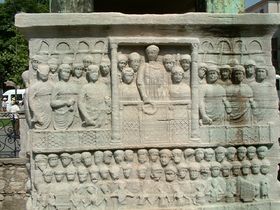Obelisk of Theodosius
The obelisk was first erected during the 18th dynasty by Pharaoh Thutmose III (1479–1425 BC) to the south of the seventh pylon of the great temple of Karnak.
The Roman emperor Constantius II (337–361 AD) had it and another obelisk transported along the river Nile to Alexandria to commemorate his ventennalia or 20 years on the throne in 357.
[2] Each of its four faces has a single central column of inscription, celebrating Thutmose III's victory over the Mitanni which took place on the banks of the Euphrates in about 1450 BC.
On one face Theodosius I is shown offering the crown of victory to the winner in the chariot races, framed between arches and Corinthian columns, with happy spectators, musicians and dancers assisting in the ceremony.
It reads: Translation: On the west face the same idea is repeated in two elegiac couplets rendered in Byzantine Greek, though this time it reports that the re-erection took 32 days (TPIAKONTA ΔYO, last line) not 30:[2]


